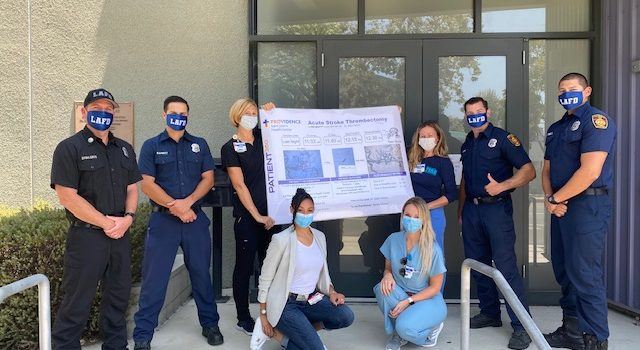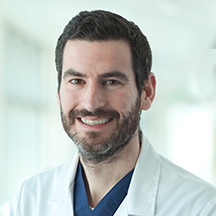

Teamwork for Another Stroke Patient Success Story
by Kamila Szweda
Pacific Neuroscience Institute’s stroke team at Providence Saint John’s Health Center and EMS come together safely during Covid-19 to provide life-saving stroke treatment
A call of CODE STROKE is an everyday happening in a busy hospital, and for a person who is struck down by a stroke, it is an emergency that needs to be cared for right away.
That’s why it was literally a lifesaver when a 75-year old patient, was found by his neighbor.
Because a Neighbor Recognized Stroke Symptoms
Ernie’s1 success story starts with his neighbor who recognized his symptoms and called 9-1-1.
Ernie had had a stroke. He was unable to move his right arm and unable to speak.
With stroke patients, time is of utmost importance as is the teamwork which starts with community recognition and the activation of emergency services.
Emergency Medical Services (EMS) and Stroke Team
Ernie was brought to Providence Saint John’s Health Center’s ER by the Emergency Medical Services (EMS) professionals at Los Angeles fire station 62. Upon arrival and evaluation, the EMS team was able to pre-notify Saint John’s emergency department of Ernie’s condition and his imminent arrival.
EMS reported a positive LAMS score which is the Los Angeles Motor Scale that scores patients based on facial droop, arm drift and grip strength. A positive LAMS score is considered 4 or 5. Ernie’s LAMS score was a 4.
The stroke team and emergency staff at Saint John’s was ready for Ernie before he had even arrived.
Stroke Treatment at the Hospital
Upon arrival, Ernie was taken directly to imaging and was found to have had a stroke in the left side of the brain. He was emergently taken for a procedure to remove the blood clot that was blocking the blood flow to his brain causing the stroke.
Dr. Jason Tarpley, Director of Pacific Stroke & Neurovascular Center, and the interventionalist performing the procedure was able to remove the clot at the lightning-fast speed of 57 minutes from when Ernie was brought in the door.
The “door-to-device” time at Saint John’s – the time from when the patient arrives at the emergency department to the removal of the blood clot to restore normal blood flow to the brain – is among the fastest in LA County.
“We’re pleased to say that Ernie did very well with no lingering effects of the stroke he suffered, said Dr. Tarpley. “He’s had a full recovery and is now able to move and use his right arm, and speak and communicate in the same way as prior to the stroke.”
Being Safe
It’s important for people to know that in cases of emergencies such as stroke, the hospital is a safe place during the pandemic and at Saint John’s, we’re here to provide lifesaving measures.
How to Identify a Stroke: BE FAST
Recognizing the signs and symptoms of stroke saved Ernie’s life. Here is what to look out for if you suspect a stroke.
B – balance. Does the person have sudden loss of balance?
E – eyes. Has the person lost vision in one or both eyes?
F – face. Does the face look uneven / drooping?
A – arms. Weakness or numbness in one arm?
S – speech. Does the person have slurred speech or trouble speaking? Confusion?
T – time. Time is brain! Call 9-1-1 NOW!
About Dr. Jason Tarpley

Jason W. Tarpley, MD, PhD, is a board-certified neurologist with fellowship training in vascular neurology. He is director of the Pacific Stroke & Neurovascular Center and specializes in ischemic and hemorrhagic stroke, cerebral aneurysms, and carotid artery stenosis.
1Patient wished to remain anonymous.
About the Author

Kamila Szweda
Kamila Szweda, RN, MSN, FNP, is a neurointerventional surgery nurse practitioner at Providence Saint John’s Health Center in Santa Monica, CA. Born in Poland, and raised in Massachusetts, Kamila has worked as orthopedic neurology nurse in an inpatient setting and developed an educational total joint program for patients. After obtaining his MSN and completing family nurse practitioner program, Kamila was a primary care provider in internal medicine while working as a hospitalist. He is a member of Sigma Theta Tau Honor Society of Nursing and is board certified with AANP.
Last updated: September 11th, 2020